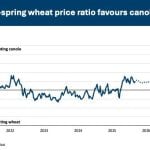NASHVILLE, Tenn. – According to revised dietary guidelines in the United States, eating the right kind of fat can improve human health.
That could be good news for the beef industry, which has been chasing after fat-avoiding consumers since the mid-1970s when food guides identified excessive fat consumption as a leading cause of heart disease and high cholesterol.
The current diet message is to reduce trans fats from the diet while adding adequate amounts of monounsaturated fats and omega 3 fatty acids.
“Our current message is choose fats wisely,” said dietitian Penny
Read Also

Farmers urged to be grain-safe this fall
Working around grain bins comes with risk, from farmers falling to drowning in grain: Experts have five tips to help avoid grain-related accidents this harvest.
Kris-Etherton of Pennsylvania State University during a special nutrition symposium at the National Cattlemen’s Beef Association convention in Nashville.
The leading cause of death among men and women is heart disease, often exacerbated by obesity.
“Some states have more than 30 percent of the population defined as obese in 2005,” she said.
The NCBA has funded nutrition research to convince more people to add beef to their diets as a nutrient dense food containing protein, iron, zinc, protein, phosphorus and magnesium.
Nutrient dense foods provide substantial amounts of vitamins and minerals and relatively fewer calories. Food low in nutrient density supplies calories but relatively small amounts of micronutrients.
Studies show 80 percent of children do not get enough Vitamin E. About 20 percent do not meet dietary requirements for phosphorus and 35 percent do not get enough magnesium. Adults are also deficient in vitamin E, thiamin, niacin, riboflavin and magnesium.
Women older than 24 are also short changing themselves on iron and zinc.
“Beef could really help women achieve nutrient adequacy,” Kris-Etherton said.
To raise beef’s profile, scientists have been hired to examine beef fat and find ways to enhance it so people get the benefits of added conjugated linoleic acid, omega 3 fatty acid and stearic acid.
Some enhancements can be achieved by breeding the right genetics into cattle, but tailored feeding programs increase beneficial fatty acids with less time and effort.
The trend is to remove or reduce trans fats from food because they have been linked to an increased risk of heart disease and Type 2 diabetes. Trans fats produced by industrial hydrogenation make a solid fat, which is used in many processed foods.
People need omega 3 and six fatty acids but cannot manufacture them.
Biochemist Pramod Khosla of Wayne State University in Detroit said 500 milligrams of these fatty acids may be needed to reduce cardiovascular risk.
Pregnant women and infants need more of these fatty acids for good cognitive function, improved mental health, such as less post partum depression and reduced risk of macular degeneration of the eyes.
“There is a whole series of diseases where they have been implicated,” said Khosia, who specializes in the role of diet in relation to neurodegenerative diseases.
One way to improve omega 3 levels in beef is to feed cattle flaxseed, said animal scientist Jim Drouillard at Kansas State University.
Animals also derive benefits from having more omega 3 in their diets. Flax feeding increased marbling and seemed to improve the immune system, which reduced the need for antibiotics.
Adding 10 percent flax to the ration showed a 1,000 percent increase in beef omega 3, Drouillard said.
The downside was a deterioration in beef colour after seven days on the shelf, which meant animals needed vitamin E supplements to prevent oxidation. Vitamin E supplementation is common practice in Canada.
Drouillard said researchers have found that the percentage of flax in a feeding ration shouldn’t exceed 10 percent because the feed isn’t as palatable beyond that level.
The short supply of flax in the U.S. can hinder a flax feeding program. He said an alternative is feeding cattle oleic rich sunflowers.
Ultimately, Drouillard sees omega 3 enhanced beef as a specialty product for the health conscious.
“Many of these opportunities would be niche opportunities to add extra value to specific audiences.”
In human studies, people who eat ground beef containing extra oleic acid showed improvements in cholesterol levels, said Steve Smith of Texas A & M University.
Oleic acid is found in olive oil and is abundant in beef. It has been found to lower bad cholesterol without affecting the beneficial cholesterol.
Three cholesterol studies that fed men five quarter pound ground beef patties per week containing more oleic fatty acid showed improved cholesterol levels over those eating conventional beef.
Researchers conducting the studies also noticed that the cholesterol particle size changed.
Large particles of bad cholesterol do not adhere to blood vessel walls.
The results suggested ground beef products could be formulated to deliver nutritionally beneficial amounts of unsaturated fatty acids such as oleic acid.















